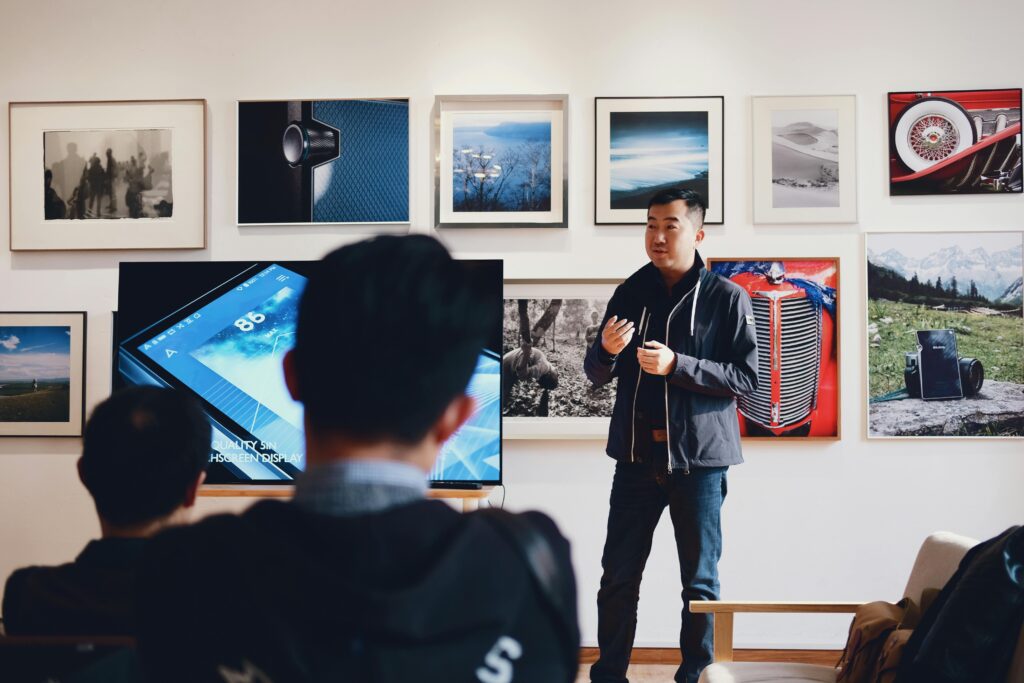Planning Inclusive Group Activities for Neurodivergent Staff

Photo by Alexander Suhorucov from Pexels
If you’ve ever watched a neurodivergent colleague quietly opt out of a team activity—or found yourself doing the same—you’re not alone.
Here’s the truth: Your most brilliant, creative, problem-solving team members aren’t avoiding team building because they’re unsociable. They’re protecting themselves from environments that feel like sensory assault courses with unclear social expectations.
But what if team building actually gave energy instead of draining it? What if it became the highlight of your team’s week—rather than something people “have a conflict” for?
This guide will help you design those kinds of sessions, where inclusion isn’t an afterthought but the starting point.
The Hidden Crisis: Why Team Activities Leave 1 in 7 Employees Behind
Picture this:
You receive a vague email:
“Surprise team-building session. 2pm. Just bring your energy!”
No agenda.
No context.
Just a performance.
For a neurodivergent brain, that’s not fun—it’s a cortisol spike.
In the UK, around one in seven people are neurodivergent—this includes the neurominority group that consists of autism, ADHD, dyslexia, dyspraxia, and more.
Yet, many team-building sessions are unintentionally built to exclude.
That’s not just a missed opportunity.
It’s a systemic design flaw.
The True Cost of Poorly Designed Team Activities
Financial Impact:
-
£8 billion is lost annually due to under-supported neurodivergent employees
-
32% higher turnover among neurodivergent team members who feel excluded
-
£3,000+ average cost to replace a single employee

Photo by Craig Adderley via Pexels
Human Impact:
-
67% of neurodivergent staff feel anxious about mandatory team activities
-
43% have called in sick to avoid group sessions
-
78% say they have valuable ideas but struggle to contribute in standard formats
But here’s the good news:
- 63% of UK employees say that neuroinclusive practices improve wellbeing.
- 43% say their teams perform better when participation is flexible.
Who Are We Designing For?
Neurodivergence is not a single identity. It’s a spectrum of exceptional strengths and unique needs. Here’s a quick guide to help you think inclusively:
| Neurotype | Strengths | What They May Need |
|---|---|---|
| ADHD | Innovation, hyperfocus, problem-solving | Structure, movement breaks, flexible input options |
| Autism | Pattern recognition, honesty, precision | Predictability, sensory safety, time to process |
| Dyslexia | Creativity, empathy, big-picture thinking | Visual aids, no pressure to read aloud |
| Dyspraxia | Strategy, resilience, kindness | Clear instructions, no coordination tasks |
| Dyscalculia | Verbal strengths, creative approaches | Alternatives to number-based tasks |
The Transformation: What Happens When You Get It Right
Imagine walking into a session where:
-
You received the agenda five days ago (with sensory info included)
-
You can share ideas via chat, diagrams, notes or drawings—whatever works
-
There’s a quiet space nearby to recharge
-
No one’s forced to speak; participation is always optional
-
Fidget tools are on the table, not smuggled in
This isn’t a fantasy. Companies like JPMorgan Chase, KPMG, and SAP are already seeing:
-
Higher engagement
-
Reduced error rates
-
More innovative thinking
The Five-Minute Fix That Changes Everything
Try sending this before your next team session:
Subject: Brainstorm Session – All the Details
Hi team,
We’re meeting on Tuesday from 2 to 3:30 p.m. in Conference Room B (quiet space, natural lighting, max 8 people).
Break: 15 mins at 2:45 pm
You can contribute by speaking, using sticky notes, chatting, or drawing—whatever feels comfortable.
Prefer async? Submit ideas via Slack by Thursday, 5pm.
Fidget tools are available, and there’s a quiet recharge room nearby.
Can’t wait to hear your ideas.
[Your name]
Your Neuroinclusive Activity Toolkit
Before the Session:
-
Agenda with timings (sent 5–7 days ahead)
-
Sensory details (noise level, lighting, space layout)
-
Contribution options listed (verbal, written, visual, silent)
-
Breaks clearly scheduled
-
Pre-thinking prompts provided
Sensory Audit Checklist:
-
Adjustable lighting?
-
Noise level manageable?
-
Fragrance-free?
-
Range of seating options?
-
Visual clutter removed?
During the Session:
Offer multiple ways to contribute:
| Type | Ideas |
|---|---|
| Verbal | Optional speaking, buddy system, round-robin |
| Written | Sticky notes, shared docs, and anonymous forms |
| Visual | Diagrams, maps, sketches |
| Tech | Live polls, chat, voice-to-text, Miro boards |
Facilitator Phrases to Normalise Inclusion:
-
“Listening is just as valuable as sharing.”
-
“Feel free to step out if you need a moment.”
-
“You can contribute later—no pressure to decide now.”
After the Session:
-
Send summary and replay/notes within 24 hours
-
Keep async contribution open for 48–72 hours
-
Collect feedback anonymously
Ask:
-
What felt most accessible?
-
What would you change next time?
-
How would you prefer to participate in future sessions?

Photo by Yan Krukau via Pexels
25 Neuroinclusive Activities That Actually Work
These activities are designed to include different ways of thinking, processing, and participating.
Quick Start Options (30 minutes or less)
-
Silent Start Brainstorming – 5 minutes of quiet ideation before voluntary sharing
-
Gallery Walk – Rotate around the room adding comments to posted ideas
-
Digital Collaboration Boards – Use tools like Miro, Mural or Mindmeister for live input
-
Voice Note Sharing – Share ideas asynchronously via recorded voice clips
-
Question Queue – Submit questions anonymously using tools like Slido or sticky notes
Medium-Length Sessions (30–90 minutes)
-
Skill Share Carousel – Share personal tips in multiple formats (e.g. video, diagrams, live demo)
-
Problem–Solution Mapping – Map challenges visually using mind maps or sticky notes
-
Walking Think Tank – Team reflections while walking outdoors or in large indoor areas
-
Tech Tool Testing – Try out new tools in small groups, then share discoveries
-
Async Video Creation – Record short explainer videos to share ideas or feedback
Half-Day Workshops (2–4 hours)
-
Design Thinking for Accessibility – Tackle real accessibility challenges with empathy mapping
-
Strengths-Based Project Planning – Assign tasks based on individual cognitive strengths
-
Innovation Hack Session – 3-hour sprint to solve a challenge with flexible output options
-
Customer Journey Mapping – Visually explore user experiences and pain points
-
Process Improvement Lab – Redesign existing workflows with team feedback

Photo by 祝 鹤槐 via Pexels
Full-Day Intensives (4+ hours)
-
Neurodiversity Simulation Workshop – Experience cognitive differences through guided activities
-
Strategic Planning Session – Use inclusive tools to align long-term team goals
-
Product Development Sprint – Create prototypes through fast-paced, structured collaboration
-
Training Design Workshop – Co-create inclusive training content and delivery plans
-
Culture Design Lab – Rethink team norms, values, and rituals through inclusive design
Virtual-Friendly Options
-
Breakout Rotations – Rotate small groups around focused discussion prompts
-
Digital Whiteboards – Collaborate in real time using tools like Mural or Jamboard
-
Asynchronous Video Discussions – Record and watch responses at your own pace
-
Virtual Coffee Chats – Light, optional social check-ins with gentle structure
-
Online Skill Shares – Demonstrate tools or ideas via screenshare or Loom videos
UK Law: What You Need to Know
Under the Equality Act 2010, employers are legally required to make reasonable adjustments for disabled employees—including those who are neurodivergent.
Reasonable adjustments include:
-
Sending agendas early
-
Allowing various participation styles
-
Providing quiet spaces or sensory tools
-
Giving extra time to process/respond
Photo by Vlada Karpovich via Pexels
90-Day Neuroinclusive Implementation Plan
Week 1–2: Audit past sessions, present business case
Week 3–4: Create communication templates, train facilitators
Week 5–8: Pilot with 2–3 teams, gather feedback
Week 9–12: Roll out organisation-wide, track impact metrics
Success Metrics to Track
| Area | Metrics |
|---|---|
| Participation | Engagement rate, async contributions |
| Inclusion | Feedback scores, staff wellbeing |
| Impact | Retention, productivity, fewer sick days |
Common Pushbacks (And Your Response)
“It’s too much work.”
Use templates. Start small. Track ROI.
“They’re just being awkward.”
Educate on neurodiversity. Share lived experience stories.
“We tried before, it didn’t work.”
Inclusion is iterative. Try again—with feedback.
“We can’t afford this.”
Most changes are free. Attrition isn’t.
Your Next Step
Try one of these this week:
-
Add multiple participation options to a meeting invite
-
Audit your last team session for sensory overwhelm
-
Pilot one of the 12 activities above
Final Thought
Neurodivergent employees aren’t asking for special treatment. They’re asking for a seat at the table that works for their brain.
When you build group sessions that reduce anxiety and increase access, everyone wins.
The next breakthrough idea might just come from the voice you didn’t hear before.
Inclusive team experiences aren’t a bonus — they’re a business advantage.
At Exceptional Individuals, we help you move from awkward icebreakers to truly accessible, energising sessions where neurodivergent minds thrive.
Whether you need training, audits, or full session design — we’re here to co-create something that works for every brain.
Sources:
-
CIPD. (2024). Neuroinclusion at Work Report. Retrieved from https://www.cipd.org/uk/knowledge/reports/neuroinclusion-at-work/
-
PwC. (2024). Global AI Jobs Barometer. Retrieved from https://www.pwc.com/bs/en/press-releases/pwc-2024-global-ai-jobs-barometer.htmlpwc.com
-
Exceptional Individuals. (2024). Neurodiversity Recruitment & Employment Services. Retrieved from https://exceptionalindividuals.com/exceptionalindividuals.com
-
Autistica. (2024). Neurodiversity Employers Index (NDEI®) Market Report. Retrieved from https://www.autistica.org.uk/downloads/files/NDEI-Market-Report-FINAL.pdfautistica.org.uk+1autistica.org.uk+1
-
G2 Legal. (2024). Neurodiversity in the Workplace. Retrieved from https://www.g2legal.com/news/2024/neurodiversity-in-the-workplace/g2legal.com+1audacityhealth.com+1
-
Genius Within & Birkbeck University. (2024). Neurodiversity in Business and Work Report. Retrieved from https://geniuswithin.org/wp-content/uploads/2024/09/2024-25-09-Neurodiversity-in-Business-and-Birbeck-University-Research.pdfgeniuswithin.org
-
City & Guilds Foundation. (2023). Neurodiversity Index 2024. Retrieved from https://cityandguildsfoundation.org/2023/10/neurodiversity-index-2024/cityandguildsfoundation.org
-
The Times. (2025). Neurodiverse Staff Well Suited to a Changing World. Retrieved from https://www.thetimes.co.uk/article/neurodiverse-staff-well-suited-to-a-changing-world-pmzztt69kthetimes.co.uk
-
Financial Times. (2024). UK Employers Eye ‘Competitive Advantage’ in Hiring Neurodivergent Workers. Retrieved from https://www.ft.com/content/e692c571-b56b-425a-a7a0-3d8ae617080bft.com
-
People Management. (2024). Neuroinclusion at Work: Learning from a Global Study. Retrieved from https://www.peoplemanagement.co.uk/article/1865721/neuroinclusion-work-learning-global-studypeoplemanagement.co.uk+1peoplemanagement.co.uk+1
-
CIPD. (2024). Resourcing and Talent Planning Report. Retrieved from https://www.brianheger.com/resourcing-and-talent-planning-report-2024-cipd/brianheger.com
-
Autistica. (2024). The NDEI®: Lead the Way for Neuroinclusion in the Workplace. Retrieved from https://www.autistica.org.uk/get-involved/employers/ndeiautistica.org.uk+1autistica.org.uk+1
-
Neurodiversity in Business. (2023). Neurodiversity in Business Report. Retrieved from https://www.neurodiversityinbusiness.org/wp-content/uploads/2023/06/Neurodiversity-in-Business-report_June-2023_Digital.pdfneurodiversityinbusiness.org
-
G2 Legal. (2024). G2 Legal’s Neurodiversity Questionnaire. Retrieved from https://www.g2legal.com/news/2024/g2-legals-neurodiversity-questionnaire/g2legal.com+1g2legal.com+1
-
Pearn Kandola. (2024). Neurodiversity at Work Report. Retrieved from https://pearnkandola.com/wp-content/uploads/2024/07/Neurodiversity-At-Work-Report-2024.pdfpearnkandola.com
-
Autistica. (2024). Neurodiversity Employers Index (NDEI®) Market Report. Retrieved from https://www.autistica.org.uk/downloads/files/NDEI-Market-Report-FINAL.pdfautistica.org.uk
-
People Management. (2024). Third of Neurodivergent Employees Dissatisfied with Workplace Support, Report Shows. Retrieved from https://www.peoplemanagement.co.uk/article/1910571/third-neurodivergent-employees-dissatisfied-workplace-support-report-showspeoplemanagement.co.uk+1peoplemanagement.co.uk+1
-
CIPD. (2024). New CIPD Guidance Shows One in Five Neurodivergent Employees Experienced Harassment or Discrimination at Work Because of Their Neurodivergence. Retrieved from https://www.thehrdirector.com/legal-updates/legal-updates-2024/new-cipd-guidance-shows-one-five-neurodivergent-employees-experienced-harassment-discrimination-work-neurodivergence/thehrdirector.com
-
Spill. (2024). 64 Workplace Burnout Statistics You Need to Know for 2024. Retrieved from https://www.spill.chat/mental-health-statistics/workplace-burnout-statisticsspill.chat
-
Cornell University. (2024). Best Practices to Support Neurodiversity in the Workplace. Retrieved from https://www.ilr.cornell.edu/sites/default/files-d8/2024-09/Cornell%20CAROW%20Webinar_Best%20Practices%20to%20Support%20Neurodiversity%20in%20the%20Workplace_June2024.pdfilr.cornell.edu





